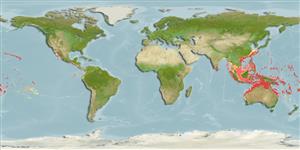>
Eupercaria/misc (Various families in series Eupercaria) >
Labridae (Wrasses) > Cheilininae
Etymology: Oxycheilinus: Greek, oxys = sharp + Greek, cheilos = lip.
Issue
Genus B. Mundy, pers. comm.
Environment: milieu / climate zone / depth range / distribution range
Ekologi
marina revassocierade; djupintervall 0 - 160 m (Ref. 1602). Tropical; 30°N - 30°S
Eastern Indian Ocean and Pacific Ocean: Christmas Island in the eastern Indian Ocean to the Hawaiian, Marquesas and Tuamoto islands, north to the Ryukyu Islands, south to Rowley Shoals in northwestern Australia, New Caledonia, and Rapa.
Size / Vikt / Age
Maturity: Lm ? range ? - ? cm
Max length : 46.0 cm TL hane/ej könsbestämd; (Ref. 2334); publicerad maxvikt: 1.4 kg (Ref. 2334)
Taggstrålar i ryggfenan (totalt) : 9; Mjukstrålar i ryggfenan (totalt) : 10; Taggstrålar i analfenan: 3; Mjukstrålar i analfenan: 8 - 11. Adults developing a distinctive black blotch covering the rears of the dorsal and anal fins (Ref. 37816). Display a bright white band over the tail (Ref. 48636). White bar often present on caudal peduncle (this pattern very changeable). Red lines radiating posteriorly from eye continuous across opercle to posterior opercular edge. Membranes of spinous portion of dorsal fin smooth, not incised (Ref 9823).
Usually solitary in coral rich areas of clear lagoon and seaward reefs. Hovers well above the bottom (Ref. 9710, 48636). Young secretive in soft corals and hydrozoans (Ref. 48636). Benthopelagic (Ref. 58302). Feeds mainly on fishes, shrimps and other crustaceans (Ref. 9823). May be ciguatoxic (Ref. 37816). Minimum depth reported taken from Ref. 128797.
Life cycle and mating behavior
Könsmognad | Reproduktion | Lek | Ägg | Fecundity | Larver
Oviparous, distinct pairing during breeding (Ref. 205).
Westneat, M.W., 1993. Phylogenetic relationships of the tribe Cheilinini (Labridae: Perciformes). Bull. Mar. Sci. 52(1):351-394. (Ref. 7441)
IUCN Red List Status (Ref. 130435: Version 2024-1)
Threat to humans
Reports of ciguatera poisoning (Ref. 4887)
Human uses
Fiskeri: mindre kommeriell; Akvarium: Kommersiell
Verktyg
Special reports
Download XML
Internet-källor
Estimates based on models
Preferred temperature (Ref.
123201): 23.6 - 28.9, mean 27.3 °C (based on 690 cells).
Phylogenetic diversity index (Ref.
82804): PD
50 = 0.5020 [Uniqueness, from 0.5 = low to 2.0 = high].
Bayesian length-weight: a=0.01585 (0.00700 - 0.03587), b=2.95 (2.76 - 3.14), in cm total length, based on LWR estimates for this (Sub)family-body shape (Ref.
93245).
Trofisk nivå (Ref.
69278): 4.1 ±0.70 se; based on food items.
Resiliens (Ref.
120179): Mellan, lägsta populationsfördubblingstid 1,4-4,4 år (Preliminary K or Fecundity.).
Fishing Vulnerability (Ref.
59153): Moderate vulnerability (36 of 100).
Nutrients (Ref.
124155): Calcium = 39 [14, 82] mg/100g; Iron = 0.643 [0.226, 1.421] mg/100g; Protein = 18.8 [15.8, 20.9] %; Omega3 = 0.157 [0.080, 0.306] g/100g; Selenium = 42.4 [13.9, 124.5] μg/100g; VitaminA = 101 [32, 370] μg/100g; Zinc = 1.48 [0.66, 2.58] mg/100g (wet weight);
